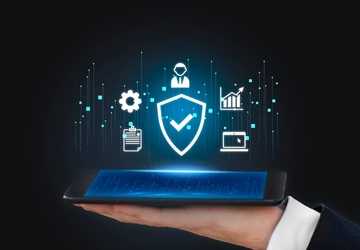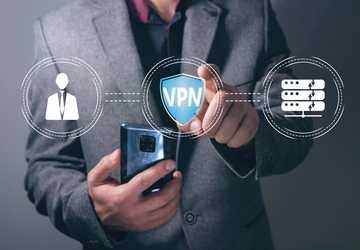In the dynamic landscape of today's digital age, where connectivity is pivotal, safeguarding your organization's sensitive data is non-negotiable. The establishment of a secure Virtual Private Network (VPN) stands as a paramount strategy in fortifying your organization against cyber threats.
This comprehensive guide navigates the intricate process of setting up a robust VPN, ensuring not only the confidentiality of your data but also the obscurity of your network. Join us on this journey to demystify the essentials, empowering your organization with the knowledge to create a secure and resilient digital infrastructure.

Before delving into the intricacies of setting up a secure VPN, let's grasp the fundamental concepts. A VPN creates a secure, encrypted connection between two points, often between an employee's device and the organization's internal network. This encrypted "tunnel" safeguards data from prying eyes, which is especially important when transmitting sensitive information over the internet.
Selecting the appropriate VPN protocol is the first step in establishing a secure connection. There are several protocols available, each with its strengths and weaknesses. The most common options include:
OpenVPN: Known for its open-source nature, strong security protocols, and versatility, OpenVPN is a popular choice. It supports both TCP and UDP protocols, providing flexibility based on your specific needs.
IPsec (Internet Protocol Security): Often used in combination with other protocols, IPsec provides robust security features. It operates at the network layer, encrypting and authenticating data packets for enhanced protection.
L2TP/IPsec (Layer 2 Tunneling Protocol with IPsec): Combining the strengths of L2TP and IPsec, this protocol offers a balance between speed and security.
SSTP (Secure Socket Tunneling Protocol): Developed by Microsoft, SSTP ensures secure data transfer by encapsulating the VPN traffic in an SSL tunnel. It is particularly effective in environments where other protocols might face restrictions.
Before diving into the setup process, pause to comprehend your organization's necessities. Consider the quantity of remote users, the kind of data exchanged, and the devices in play. It guarantees that your selections harmonize with your organization's distinct needs, establishing a robust groundwork for a secure and customized virtual private network. Taking this step ensures that your VPN not only meets your immediate requirements but also adapts effectively to the evolving demands of your organization in our interconnected digital landscape.
Choosing the right hardware is vital for a secure and efficient VPN. Some opt for dedicated VPN appliances, while others utilize existing servers. It's like picking the right tool – it needs to fit well and adapt as your needs evolve. Consider whether your chosen solution can grow with your organization. So, whether it's a dedicated appliance or existing servers, ensure your hardware sets the stage for a VPN that's not only secure but also ready to handle the growth of your organization.
Ensuring only authorized personnel access your organization's VPN is crucial. Robust authentication, like Multi-Factor Authentication (MFA), adds a layer of security. Individuals confirm their identity by using a password in conjunction with a temporary code delivered to their mobile device. This double-check system makes it harder for unauthorized access, keeping your VPN secure and your data safe.
At the core of a secure VPN is how it keeps things safe, mainly through encryption. Choose robust, well-known encryption methods to protect your data effectively. AES (Advanced Encryption Standard) is a trusted option known for its security. It comes with different key lengths, adding extra layers of protection. So, when setting up your VPN, make sure to prioritize these secure encryption methods to keep your information safe and sound.

Effective VPN management is crucial for security. Creating a centralized system streamlines monitoring, updates, and policy enforcement. This approach guarantees your VPN stays strong against new threats, maintaining consistent configurations across all points. This centralized setup simplifies control, ensuring your VPN is always up-to-date and secure, shielding your organization from evolving risks with ease.
By adding NAT and firewalls to your VPN, you're putting up an extra shield against bad stuff. NAT hides internal IP addresses, giving more privacy, and firewalls keep an eye on all the coming and going internet traffic, stopping sneaky access. It's like having an extra lock on your door, making sure only the right people get in, and keeping your online space safer. So, with these buddies on board, your VPN becomes a tougher guard, making sure your information stays private and your online neighborhood stays secure.
By consistently monitoring and analyzing logs, your organization can take proactive steps to detect and respond swiftly to potential security breaches. Regularly reviewing these logs helps pinpoint any unusual patterns or activities, enabling a prompt and effective response to address security concerns. This ongoing commitment to monitoring ensures a vigilant approach to safeguarding your organization's digital assets from evolving cyber threats.
Despite having a secure VPN, human error remains a big player in cybersecurity. It's crucial to offer comprehensive training to your staff, focusing on VPN best practices. Stress the importance of using strong passwords, ensuring secure device usage, and staying vigilant for any suspicious activities. By arming your team with the appropriate knowledge, you establish an extra line of defense, guaranteeing that each member contributes to safeguarding the security of your organization's digital infrastructure.
In conclusion, establishing a secure VPN is not merely a technological necessity but a strategic imperative for safeguarding your organization. By implementing robust protocols, encryption methods, and centralized management systems, you create a formidable defense against cyber threats.
Regular updates, user training, and diligent monitoring further enhance the resilience of your VPN. As the digital landscape continues to evolve, a well-secured VPN not only protects sensitive data but also ensures a reliable and confidential network for seamless organizational operations in the face of an ever-changing cybersecurity landscape.